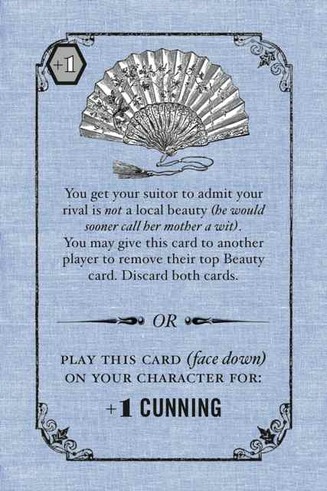 Jane Austen refers to “cunning" in Pride and Prejudice and her other works. In my upcoming card game “Marrying Mr. Darcy," how Cunning a character is, and how they use Cunning during the game is a key part of the strategy of the game. Cunning does not earn you any points at the end of the game. However, it can be used to your advantage in two ways. First, looking at the top of the card, you may blemish another players character by forcing them to discard a card they have played, in this case beauty. This causes the rival character to lose points, but also might affect which Suitors are interested them. If you want a particular Suitor to yourself, this could be a good strategic move. The other way you can use Cunning is to play it on yourself, facedown. The Character who has acquired the most Cunning points at the end of the Courtship Stage of the game, will be the first character to roll for to see which Suitor proposes in the Proposal stage. This is a huge advantage, since there will be fewer Suitors available as the Proposal stage goes on.
1 Comment
8/2/2021 06:35:38 am
Prejudice card game and all offer is fit for the approval of the terms for the citizens. The round of the https://profvalue.com/successful-business-tips-for-students/ is flicked for the changes. The margin is approved for the guides. The pride and card game is played for the few people.
Reply
Leave a Reply. |
Erika SvanoeMusician, conductor and game designer. Archives
November 2015
Categories
All
|
|
Erika Svanoe Games is an indie board game publisher located in Wisconsin. It was created to publish Marrying Mr. Darcy and related projects.
|
Marrying Mr. Darcy is copyright © 2013, 2021 Erika Svanoe. It is proudly self-published through Erika Svanoe Games, and distributed through Quartermaster Logistics.
|
Custom illustrations and graphic design are copyright © 2013, 2021 Erik Evensen. Vintage graphics are sourced from public domain sources by The Graphics Fairy, and used with permission.
|
Proudly powered by Weebly

 RSS Feed
RSS Feed
